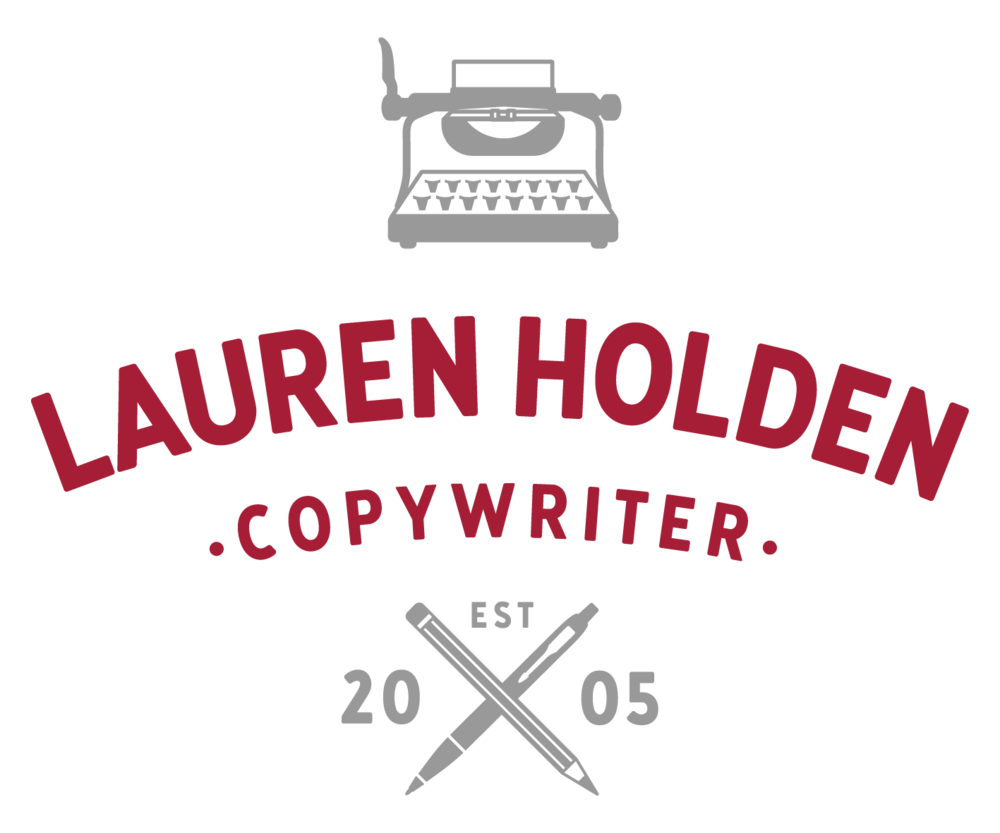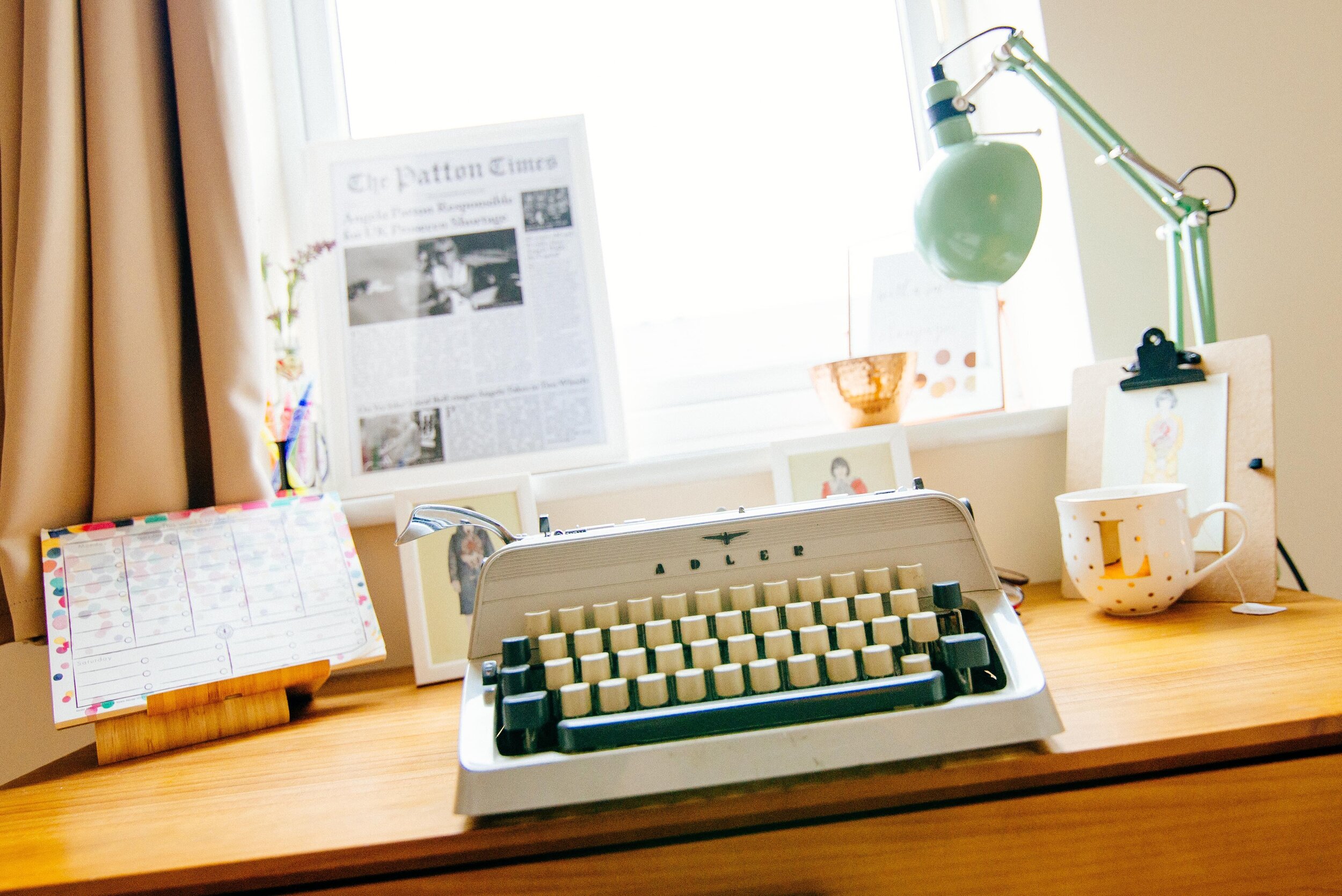Well, this certainly feels very self-indulgent. It really does.
A whole post about meeeeeee and what I do for a living. Pah. Bear with me, though. There’s a reason I’m writing it - and it’s this: I get more than a few emails a week from would-be copywriters asking me how my day pans out and if I’d recommend writing for a living.
The answers? No two days are the same and: ‘YES, ABSOLUTELY’. Copywriting’s a very rewarding - if a bit challenging, sometimes - career.
I love it so much, in fact, that it doesn’t feel like a job and is more like a happy little hobby I happen to get paid to indulge in. Yes, really. For me, there’s nothing better than getting to the nitty gritty of a person (or their business) and ensuring my content does them and their work the justice they deserve.
If you love words and people, too, you’re bound to get as much joy as I do from writing words for people.
What exactly is copywriting then?
I get asked this a lot, too. Basically, ‘copy’ means ‘text’ or ‘content’ - so copywriting is essentially the writing of any kind of text.
Seriously, any kind of text you can think of.
Text for websites, brochures, e-newsletters, menus, signs for vans and cars, banner ads, Spotify adverts, radio adverts, press releases - and anything and everything in between. If it has a physical (or digital) surface, try me; I could probably write something on it.
Here’s what a copywriter isn’t:
Anything to do with the ‘copyright’ of products, brands or films. It’s a confusing one because, while it sounds the same, it’s spelled differently
Someone who ‘copies’ people’s work. Well, I can’t say the same for other copywriters, but all my ideas are legit my own. I know; I’m not as daft as I look.
So, how does a normal day pan out for we copywriters?
Again, I can’t speak for other copywriters. Some work from home (like me) and others craft their content in-house for a company or an agency. But for a self-employed copywriter like me, here’s how a normal day from home might go…
And while I started putting this blog post together weeks ago, I’m hoping now is as good a time as any to share it. What with the covid-19 pandemic, more of us are working from home, so my own productivity tips may well help you, too.
7am - My alarm goes off and I bound out of bed. I jest, because these days I’m not much of a morning person and my kind of bounding out of bed usually means reluctantly slipping out of the sheets, onto the bedroom floor and into the bathroom for a shower. It’s easy to think I’ll just hit ‘Snooze’ on my alarm for another hour when ‘you’re the boss of you’, but I imagine that’s a slippery slope to not doing enough work and letting down clients.
So, I try to make my day as ‘routine’ as it might be if I was heading into an actual office and not my makeshift one at home. A quick change, some breakfast (eggs usually, if you’re asking) and half an hour or so in front of the news on t’telly and I’m more or less ready to begin work.
8.30-9am - Some mornings are slower than others but I tend to sit at my desk - in my lovely little home office - no later than 9am. It’s when my clients will email or call (should any of them need anything) and I don’t like to leave anyone waiting too long for a response. I’ll usually pick a vinyl record or a Spotify playlist to play while I’m typing away - and once my laptop’s on and I’ve written a quick to-do list, I’ll crack on.
9am - My first job of the day tends to be to update a few of my clients’ social media accounts with fresh content their followers can enjoy. If I was a really organised copywriter, I’d have planned a month’s worth of content in advance (and sometimes I do), but thinking up a new update on the day itself means I can ensure it’s a bit more ‘topical’. Currently, I create social media content for the following companies: AAAtraq and Breton Shirt Company (as pictured below).
10am - Once I’ve uploaded or scheduled those small snippets of content, I’ll have another quick check of my inbox and my own social media channels, including Facebook and Instagram, to reply to any enquiries from new or existing clients.
Then I’ll get my teeth into any larger projects I’ve been working on. This varies from day-to-day; I can be working on anything from a full website rewrite to a proofreading job, or even script editing. My online portfolio gives you some indication of the kind of projects I take on - just click on the individual images to see my range of services.
Solid Writing Time
I work in blocks, allocating at least an hour at a time to any piece of work.
I tend not to exceed about two hours in one sitting. If you’re a copywriter too, you’ll know writing can be quite emotionally draining. If you’re not a copywriter, I often compare solid writing time to sitting behind the wheel of a car on a driving lesson or a test. That was a long time ago for me (and it took me six tests before I passed, so I know all too well how draining it is); that level of concentration can’t be sustained for more than a couple of hours at a time - and it’s the same for me when writing copy. Any more than a couple of hours in one sitting and I need at least half an hour or so to do something else entirely.
Once I feel like I’ve made some headway with the piece I’m working on, I’ll consult my list and see how I’m getting on. If I’m happy with the work I've completed so far, I’ll break off for some lunch. If not, I’ll sit a while longer and have another look at the work I’ve created. Sometimes I’ll completely delete it before starting again, but often, I’ll make a quick coffee and see if I can come back to it with a fresher pair of eyes and a more caffeinated head.
A Treat at the End of the Tunnel
I tend not to put more than a handful of items on any one list (usually three, to be honest). Try it, too - it means you’ll feel less overwhelmed.
Another of my top tips for working from home is this: promise yourself a short, five or 10-minute break at the end of each hour’s work. Whether it’s for making a cup of tea or sitting down to a slice of cake, it’ll make you work harder for that hour, knowing there’s a treat at the end of it. I call it a ‘treat at the end of the tunnel’, because, when I’ve been writing for a bit, I feel like you do when you come out of the dark cinema into the light. It’s an odd feeling, isn’t it: like you haven’t seen daylight for a bit.
I’d recommend you hold off checking your inbox during each hour of writing time, as well; falling down the ‘inbox-shaped rabbit hole’ means you’ll feel like you’ve accomplished less at the end of the day.
12pm-1pm (Lunch!)
While it doesn’t always happen, I try to give myself at least an hour’s respite from the glare of my laptop screen. I’d like to say I’m one of those people who heads outside for a spot of fresh air, but I tend to make myself a nice lunch and sit in front of the TV catching up a programme my husband refuses to watch. We have very different tastes when it comes to telly or films, so I use the time to indulge in something completely guilt-free. Sometimes - and while the weather’s warmer - I'll disappear into the garden with a book.
1pm
I allow myself a small slot of time to check my emails and respond to any queries or make a couple of quick calls to clients. Sometimes this takes 10 to 20 minutes, sometimes more. But once I’ve finished doing that, I get back to some more writing and try not to check my inbox..
1.30pm - 3.30pm
Now’s the time to get onto some more writing - and I make sure I knuckle down with minimal distractions. If, after half a day spent writing, I feel I have something worthy of showing a client, I’ll send them a first draft.
I always explain that the first draft is just that - and it’s an opportunity for them to take a good look over what I’ve written and decide if A) they like what they see, or B) they absolutely don’t. Either response is fine.
I tell my clients that, often, it doesn’t matter if they hate what I’ve put together at first, as sometimes finding out what you don’t like is all part of the process. It ensures my work more than meets their expectations in the end.
For example: a client might say, “I absolutely loved this paragraph”, but that paragraph just didn’t sound like me or my company.
It helps me craft copy that hits the nail on the head across every paragraph and every last word. Of course, it all starts with a kick-off call; determining a little more about my client’s business is key to good copy, but getting inside someone’s head is the really tricky part of my role. Sometimes I manage first time, sometimes it takes a bit more to-ing and fro-ing.
3.30pm - 5pm
A quick brew break and another quick check of my emails. I’ll then spend the remainder of the day updating clients regarding my progress on their work. In some cases, I’ll have a sample paragraph of content for new clients to view. In others, I’ll have spent some time researching their brand and that of their competitors.
It’s vital, though, that I get to know each client on a personal level, understanding their quirks and their motives for starting or progressing their business.
My days sometimes involve a spot of ‘traditional journalism’, which I’m always eager to partake in.
I spent five years at a local newspaper and I hugely miss my time there. It gave me the start I needed in writing and developed my passion for people and learning about their stories. I’d like to think that makes me better at my job: getting to the bottom of why my clients do what they do is important when crafting emotive, storytelling-esque piece for their websites.
Some Top Tips for Remote Working
Have you found yourself working from home due to the coronavirus pandemic? I’ve technically been social-distancing for six years (!); as a freelance copywriter, it’s pretty much my day-to-day life to see no one face-to-face.
This is how I cope…
Create a Cosy Workspace
I recently gave my home office a makeover; a lick of paint, a good tidy and some new prints for the walls was enough to breathe new life into the space and give me even more motivation to set up camp there, day in, day out.
Try doing the same, too. While you can’t necessarily bulk buy home trinkets during this social-distancing period, you could see how you could transform it using the storage solutions, prints and pictures you already have. Set about creating a plan for sprucing it up and I promise you’ll be ready and raring to work from home.
Minimise Distractions
Sometimes distractions are good (like when a relative rings you to say hello or the postie pops by with a nice piece of post). But more often than not, distractions will put you off your work for a while.
Try to mimimise the chance of doing the housework or reorganising your wardrobe (the temptation is strong when you work from home) by shutting the door on all those things and holing up in your home office.
Maintain a Routine
It’s easy to get out of a standard 9 to 5 routine when you work from home - and there’s no pressure to even work traditional office hours when you’re your own boss. But try to stick to some form of routine - even if it’s one you’ve created for yourself - and you'll discover that motivation comes much more easily.
Treat ‘Yo Self
I work best when I know there’s a break or a treat coming my way. I talked about this earlier in this piece, but it really does benefit productivity when you work towards a goal: i.e. a piece of cake. Tell yourself you’ll break off for a cuppa and a slice of sponge just as soon as you finish, say, 500 words - and you’ll be writing beautiful prose like the wind.
Don’t Feel Guilty
There’s enough to feel guilty about in life - but not playing by the 9 to 5 rules isn’t one of them. If you work for yourself and you fancy (or need!) a morning off (and you don’t have any looming project deadlines), do it. Similarly, if you just want to spend half an hour on the phone to a friend or relative; if your workload will allow you to do that, go for it. We spend a lot of our life working - and if self-employment gives you the opportunity to be flexible in your approach to the way you work, then why feel bad about that?!
I work a lot at weekends, which means I tend not to feel rubbishy about taking the odd morning off here and there. It’s that little thing called self-care, isn’t it? And sometimes we all have a day when we need some time to relax. Plus, I always find my work is all the better for it when I’m well-rested and ready to get back to it.
Did this blog post help? I hope it gave you some insight into how a copywriter like me plans their day - and why it might make a rewarding career for you, too.
I’m currently preparing some handy, paid-for resources for would-be copywriters - do let me know if you’d like to hear more.
Until next time…









